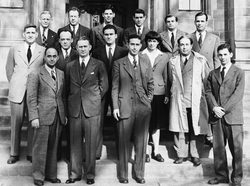Education in the United States
Education in the United States is provided by the public sector. The federal, state and local governments control and give funds to help local schools. Public education is available everywhere in the United States. School's curriculum, funds, teaching, employment and other policies are created by the elected school boards. There are also private schools, which cost money to attend.
Schools
School districts are sometimes different from other local jurisdictions. They have their own officials and budgets. Education standards and state tests are created by the state governments. Since child education is required by law, ages to start school are different from each state. Children usually start school between the ages of five to six.[1] They usually end their education when they are between the ages of seventeen and eighteen. Education requirements can be done by educating children in public schools, private schools (who is known by the government to be trusted) or a home school program. In most public schools, education is divided into three levels. The first level is elementary school. Grades in elementary school are different in each state. The second level is middle school. Grades in middle school are different in each state as well. The last level is high school. In some states, middle school is called "junior high school". Grades in high school are also different in each state. After a child has completed their senior year (12th grade), they will earn a high school diploma.[2]
Colleges and universities
If a child would like to continue on with their education or want to start a career, they can apply for college. After four years at a university or college, they will earn a bachelor's degree in one subject. Students can also choose to attend a two-year community college. Some two-year community colleges are called "Junior colleges". Colleges are not required and are not forced by local laws. Students must pay to attend college, but the price is lowered if they get a scholarship. After college, the now adult can earn a number of certificates for a career. Graduate school is another option after college. A student can earn a master's degree or Ph.D. in any subject. They may go to medical school to earn an M.D. and become a physician, law school to earn a J.D. and become a lawyer, or business school to earn an MBA.
Education In The United States Media
The 2019 graduation ceremony at Pitman High School in Pitman, New Jersey
A building on the campus of the New York Institute of Technology, founded in 1955 in Manhattan
The University of Chicago team that worked on the production of the world's first man-made, self-sustaining nuclear reactor, including Enrico Fermi in the front row and Leó Szilárd in the second
The University of Miami, founded in 1925 in Coral Gables, Florida
Brookings Hall at Washington University in St. Louis, established in 1853
References
- ↑ "State Compulsory School Attendance Laws". infoplease.com. Archived from the original on September 22, 2010. Retrieved December 19, 2007.
- ↑ "Top 100 Affordable Cities with Top Schools". Archived from the original on 2022-06-06.
Other websites
| Wikimedia Commons has media related to Lua error in Module:Commons_link at line 62: attempt to index field 'wikibase' (a nil value).. |
- EducationUSA: Your Guide to US Higher Education Archived 2007-06-30 at the Wayback Machine
- Search Training Providers in the US | Coursetakers.com
- U.S. Department of Education Archived 2008-03-06 at the Wayback Machine
- National Center for Education Statistics
- National Assessment of Educational Progress










